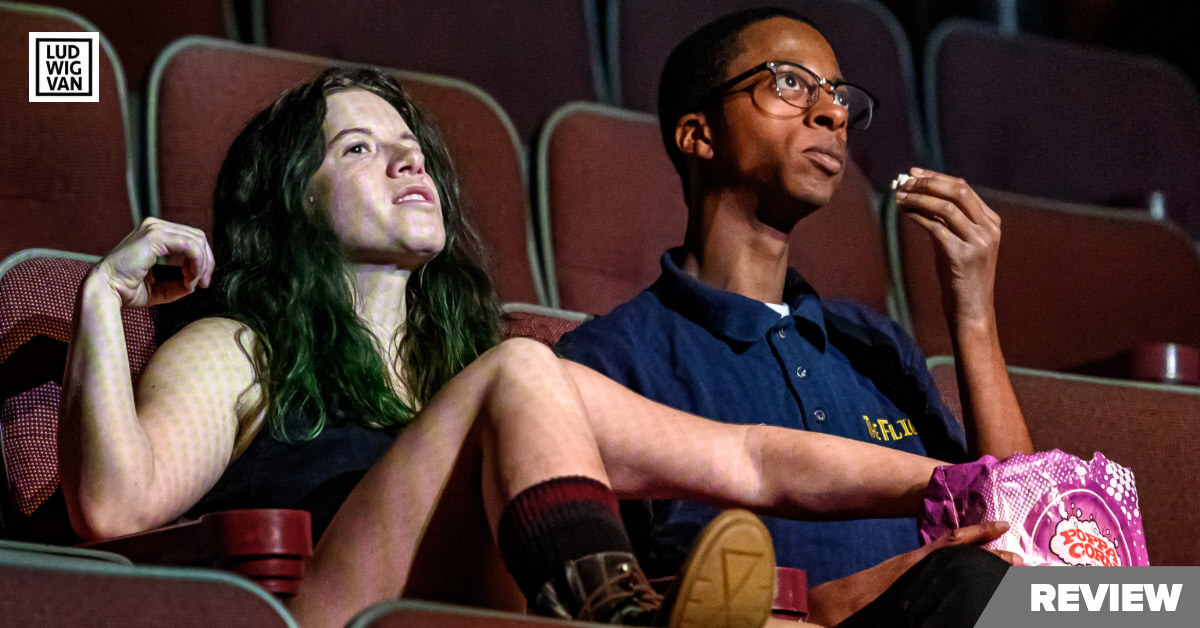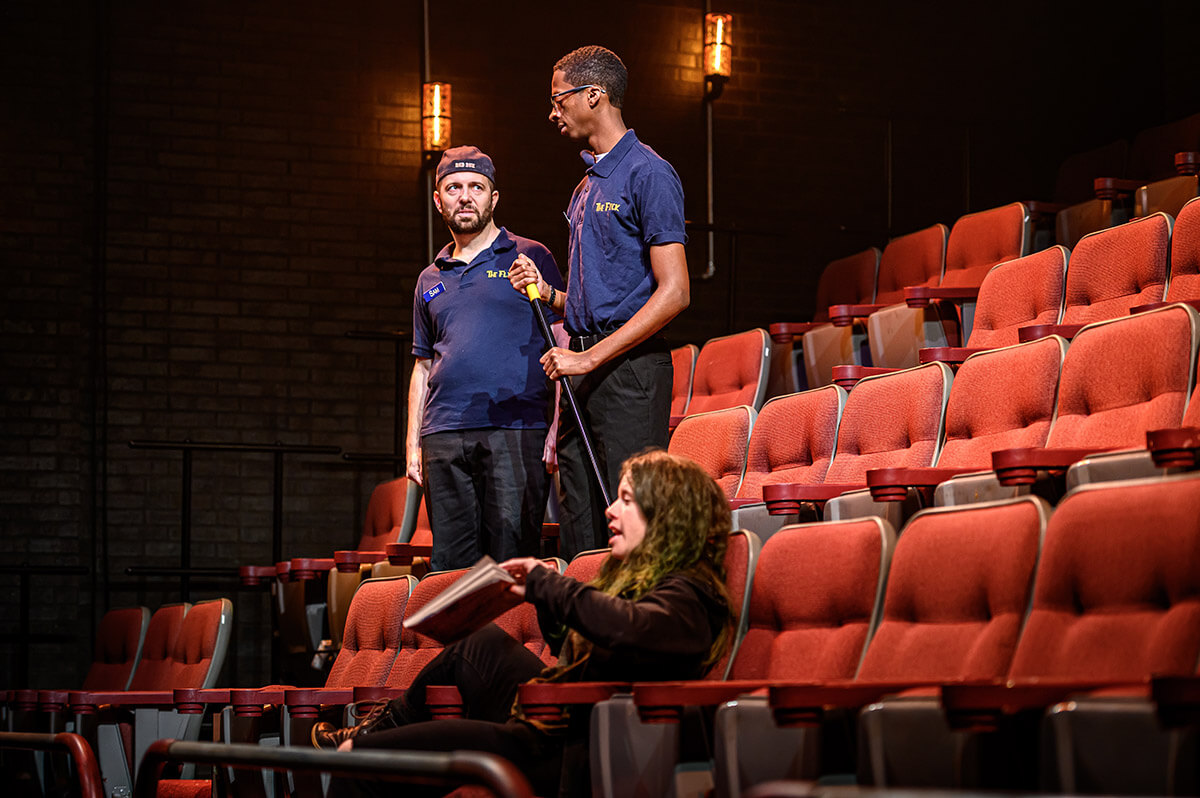
Outside the March & Crow’s Theatre/The Flick, written by Annie Baker, directed by Mitchell Cushman, Guloien Theatre, Streetcar Crowsnest, Oct. 6 to Nov. 2. Tickets available at crowstheatre.com.
The Flick had been opened just one day when the announcement came that the run has been extended. Annie Baker’s 2014 Pulitzer Prize-winning play had conquered another city.
What makes this success so remarkable is that The Flick is three hours long and nothing much really happens. Nonetheless, Baker, 38, considered one of the most gifted American playwrights of her generation, manages to infuse those three hours with utterly memorable characters who can’t fail to touch your heart. The Flick is a sweet play filled with acute insight into the human condition.
Baker’s plays have been variously called “theatre of the mundane” and “untheatrical”. The Flick is made up of vignettes that are naturalistic slices of life, replete with simple, everyday speech. Time unfolds as it should. It is 2012. The setting is a rundown art house cinema in Worcester, Massachusetts, one of only eight in the state that still uses a 35 mm film projector, rather than a digital one. For purists like usher Avery (Durae McFarlane), only a film projector can express the nuanced light and shadow as the camera intended, rather than the less subtle images generated by digital pixels.
The ushers at The Flick cinema run the box office and refreshment stand, and do the cleanup, and that’s where we meet them. Outside the March, under artistic director Mitchell Cushman, is one of the most adventurous in the city, and Crow’s Theatre’s artistic director Chris Abraham knows a good idea when he sees one. The two companies banded together to produce the giant hit Jerusalem in 2018, and if you thought that set that recreated an English forest was elaborate, designer Nick Blais’s ultra-realistic cinema re-creation will take your breath away. The bleachered stage is literally filled with seats with the projection booth above. Each time the movie is over, Avery and Sam (Colin Doyle) bring on their brooms and dustpans and, moving up and down the carpeted stairs, start sweeping up the popcorn and other detritus that litters the theatre. If Blais’ set isn’t nominated for a Dora Award, there is no justice.

The characters are all troubled in some way, and as each clean up happens, we find out a little more about them. Baker’s writing style is to dole out information that occurs naturally in conversation. Her dialogue is like an impressionist painting, where less gives us more. What binds the characters together is their loneliness. All of them are adrift in a seemingly uncaring world.
Working-class Sam is thirty-five, and lives with his parents. He never went to college, and while he has ambitions to be a chef, seems resigned to earning $8:25 an hour at this dead-end usher job. Doyle’s performance is truly breathtaking, portraying a Sam who is a fully formed individual, a friendly, decent, nice guy with a sensitive side. He likes to crack a joke or two, and who, even though he knows he’s a loser, tries to remain as positive as he can. There is a warmth to Doyle’s performance that is captivating.
Avery, who is twenty, is the new employee. He is a Black college student, the son of a professor who is currently taking a gap semester. Avery is the quintessential movie nerd who lives and breathes cinema. In fact, so encyclopaedic is his knowledge, that he is a whiz at the Six Degrees of Separation Game. Sam feeds Avery the name of two actors, and in six movies or less, Avery has to link them together. (The game also points out playwright Baker’s vast movie knowledge as well.) McFarlane is a recent university graduate who has been given the acting opportunity of a lifetime, and he nails Avery’s seemingly contradictory personality, on one hand conveying his social unease and caution in being a Black man, on the other, his rigid belief in the principles that govern his life.
We don’t ever learn as much about projectionist Rose (Amy Keating), as we do about the men, but Keating gives a rich performance nonetheless, although she has to pay more attention to projecting her voice, pardon the pun. On the outside, twentysomething Rose is a promiscuous party girl, but one who worries about her inability to maintain a lasting relationship. As opposed to the characters of Sam and Avery, Keating’s Rose exudes confidence, yet Baker also allows us to see her vulnerabilities. The fourth character is Skylar (Brendan McMurtry-Howlett), a seasoned, efficient usher, who although a new worker, has nothing to learn from Sam, and Doyle makes sure we can sense Sam’s disappointment. In fact, the roles of both Rose and Skylar are designed to impact on Sam and Avery, which Baker inputs with judicious design.

It is a mark of Baker’s skill at characterization, that through what is basic, everyday conversation, she conveys the fact that her people are complicated beings. We feel their pain. Yes, betrayal happens, and hurt is meted out, but she also allows all three major characters to show compassion, empathy and understanding towards each other, with even Avery breaking through his shell on occasion. In fact, Baker’s ability to create realistic people in real situations is astonishing. Her writing also has a sardonic edge which is where the humour in The Flick comes in, but always at its heart, is her intent to put forth the human condition at its most brave, and most frail.
I would be remiss if I didn’t mention the terrific production values. Blais’ lighting is masterful, particularly in recreating the projector beam, presumably working with projection designer Nick Bottomley. Richard Feren’s clever sound design bridges the cleanup scenes, and includes movie company fanfares, excerpts of movie music and dialogue, and of course the ever-present clicking of the movie projector itself. Anahita Dehbonehie has come up with perfect usher outfits and casual street clothes, and she is also responsible for transforming the theatre lobby into a cinema lobby, all of which makes for an Outside the March immersive experience, which is Cushman’s intent.
And speaking of director Cushman, he has been absolutely brilliant in placing his characters throughout the space. Baker’s conversations occur naturally, and Cushman has made a gutsy decision about pacing. In such a long play, the tendency might be to speed things up, but Cushman has ensured that everything occurs in real-time, no matter how slow it may feel. The play’s rhythm of life is gentle, and Cushman will not let any unnecessary theatricalism impede Baker’s slow and steady march of time.
This long play is not an epic. It deals with small people experiencing small matters, but everything that does happen is important to them. Baker’s greatness is making their small lives important to us.
[Updated, October 14, 2019. A previous version incorrectly attributed the production company to Against the Grain Theatre, when it was Outside the March.]
#LUDWIGVAN
Want more updates on classical music and opera news and reviews? Follow us on Facebook, Instagram or Twitter for all the latest.
- INTERVIEW | Actor Diego Matamoros Takes On Icon Walt Disney In Soulpepper Production Of Hnath Play - April 16, 2024
- SCRUTINY | Opera In Concert Shine A Light On Verdi’s Seldom Heard La Battaglia Di Legnano - April 9, 2024
- SCRUTINY | Lepage & Côté’s Hamlet Dazzles With Dance And Stagecraft Without Saying Anything New - April 5, 2024



